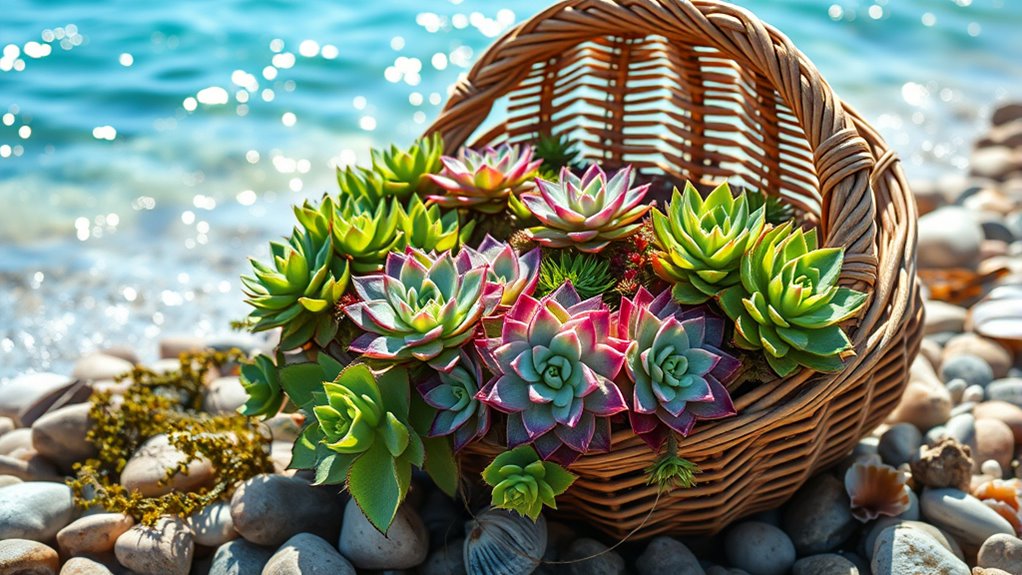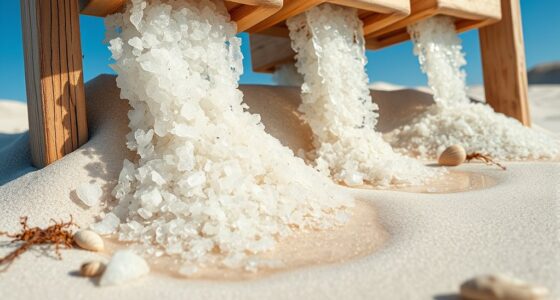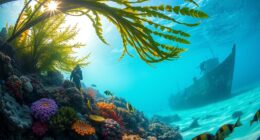To create a crisp coastal salad, gather succulent plants like sea purslane or sea beans along sandy shores, ensuring proper identification with a field guide or app. Use gentle harvesting tools to clip leaves, leaving enough behind for the plant’s health. Focus on plants near rocks or sparse vegetation and avoid any with unusual odors or milky sap. With these safe and sustainable tips, you’ll discover delicious flavors hiding at your shoreline—learn more about creating your perfect beachcomber’s basket ahead.
Key Takeaways
- Identify coastal succulents like sea purslane with fleshy leaves and vibrant colors using reliable guides or apps.
- Harvest leaves or stems carefully with scissors, removing only what’s needed to promote plant health.
- Focus on plants growing in sandy, well-drained areas near rocks or sparse vegetation for accurate identification.
- Ensure safety by avoiding plants with unusual odors, milky sap, or those that look unfamiliar.
- Practice sustainable foraging by respecting regulations, private property, and leaving enough plant material behind.

Have you ever wondered what treasures a simple basket can hold when you visit the beach? With the right foraging techniques, you can turn a casual stroll along the shoreline into a rewarding adventure. As you explore, you’ll discover that coastal areas are teeming with edible plants, especially succulents, that can elevate your salads and snacks. The key is knowing how to identify these plants correctly and gather them safely, ensuring you enjoy their flavors without harming the environment.
Begin by honing your coastal plant identification skills. Look for plants with thick, fleshy leaves—these are typical characteristics of succulents adapted to salty, arid conditions. Many coastal succulents, like sea purslane or sea beans, have distinctive features such as vibrant green or reddish hues, waxy surfaces, or unique leaf shapes. Pay close attention to their surroundings; most thrive in well-drained, sandy soils, often near rocks or in patches of sparse vegetation. Remember, not all succulents are edible, so proper identification is *vital*. Use a reliable field guide or mobile app to cross-check your finds, and avoid plants with unusual odors or milky sap, which can indicate toxicity. Accurate identification is essential to ensure safety and preserve the environment.
Identify thick-leaved succulents like sea purslane or sea beans using guides, noting their vibrant hues and habitats.
Once you’ve confidently identified an edible coastal succulent, employ gentle foraging techniques. Use scissors or your fingers to carefully clip the leaves or stems, taking only what you need and leaving enough behind for the plant to recover. Be mindful of the environment—don’t strip entire plants or disturb their roots—so the ecosystem can continue to thrive. Respect local regulations and private property, and always forage sustainably. If you’re unsure about a plant’s safety, it’s best to leave it alone—your health and the environment depend on cautious harvesting.
Frequently Asked Questions
Are Coastal Succulents Safe to Eat Raw?
You wonder if coastal succulents are safe to eat raw. While some edible plant varieties grow along the coast, you should be cautious of toxic plant indicators. Not all succulents are safe; many can cause stomach upset or worse. Always identify plants carefully, avoid those with unusual textures or colors, and consult reliable sources or experts. Never consume a succulent unless you’re absolutely sure it’s safe to eat.
How Do I Identify Edible Versus Toxic Coastal Plants?
When plant identification, you need to carefully observe leaves, stems, and flowers for distinctive features. Always research thoroughly before foraging, and follow ethical foraging practices—never harvest endangered plants or overharvest. Use reliable guides or consult experts to distinguish edible coastal plants from toxic ones. By practicing responsible foraging ethics, you guarantee safety for yourself and preservation of the ecosystem. If unsure, avoid consuming unfamiliar plants altogether.
What Tools Are Best for Foraging Succulents?
Did you know that using the right tools increases foraging success by over 50%? When harvesting succulents, you need sharp scissors or a pruning knife to guarantee clean cuts, reducing plant damage. A small trowel can help gently loosen roots, while gloves protect your hands. Always prioritize foraging safety by avoiding rusty or dull tools. With these tools, you’ll harvest efficiently and sustainably, preserving coastal plant health and your safety.
How Should I Store Coastal Succulents After Foraging?
After harvesting coastal succulents, you should store them properly to maintain freshness. Use gentle harvesting techniques to avoid damage, then rinse and pat them dry. Place the succulents in a breathable container or paper bag, and keep them in the refrigerator’s crisper drawer. This preservation method slows spoilage. Remember, timely storage helps preserve their crisp texture and vibrant appearance, ensuring they’re ready for your coastal salads whenever you want.
Can I Forage Sustainably Without Damaging the Environment?
Imagine walking along a sun-kissed shoreline, gentle waves whispering nearby. You can forage sustainably by practicing mindful harvesting—taking only what you need, leaving plenty behind. This minimizes environmental impact and ensures coastal succulents thrive for future generations. By respecting local ecosystems and avoiding overharvesting, you protect the shoreline’s delicate balance, turning your foraging into a responsible, eco-friendly activity that preserves the beauty and health of coastal habitats.
Conclusion
Just like a modern-day Odysseus gathering treasures from the sea, you uncover the coastal succulents that transform simple salads into fresh adventures. Embrace these natural gems, and let the ocean’s bounty inspire your culinary journey. Remember, the shoreline’s secrets await those willing to explore, turning everyday ingredients into a symphony of flavors. So, venture forth with confidence—you’re crafting your own epic, one crisp bite at a time.










